Publications

May 19, 2015
In the several years since the Great Recession, New Hampshire, like the nation, has witnessed and experienced growing economic disadvantage. The state’s poverty level stands at 8.4 percent, and child poverty increased from about 8 percent in 2000 to nearly 10 percent in 2012.1 Some areas of the state have been hit harder than others. In the state’s largest city of Manchester, for instance,...
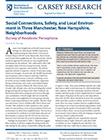
November 12, 2014
This fact sheet uses data from a survey of Bakersville, Beech Street, and Gossler Park residents in Manchester, New Hampshire, to draw attention to the current state of connectedness, trust, and perceptions of the local environment in these three neighborhoods.

May 6, 2014
This brief analyzes immigration and refugee resettlement in Manchester and the effects on the city’s demographic composition, as well as the implications for its future. Authors Sally Ward, Justin Young, and Curt Grimm report that Manchester, New Hampshire, like the nation, is experiencing a new wave of immigration.

June 11, 2013
This issue brief uses data from the Current Population Survey collected from 2003 to 2012 to assess trends in employment in middle-skill jobs and the Great Recession’s impact on middle-skill workers, with particular attention paid to differences between those in rural and urban places.
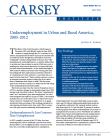
November 13, 2012
Author Justin Young reports that underemployment (or involuntary part-time work) rates doubled during the second year of the recession, reaching roughly 6.5 percent in 2009. This increase was equally steep in both rural and urban places. By March of 2012, underemployment was slightly lower in rural places (4.8 percent) compared to urban places (5.3 percent).
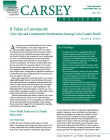
October 16, 2012
This brief explores the extent to which Coös County youth are involved in a variety of civic-related activities, with particular attention to the demographic and attitudinal factors associated with such participation. Author Justin Young reports that approximately 75 percent of Coös County youth report involvement in at least one type of civic-related activity.
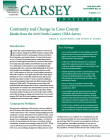
August 2, 2011
This brief from Chris Colocousis and Justin Young uses the most recent North Country CERA survey to focus on change and continuity in Coos County between 2007 and 2010, and then makes comparisons of the present conditions across the three study counties. The authors examine such topics as community problems, environmental and economic concerns, and community cohesion and confidence in the local...
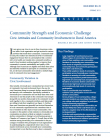
June 7, 2011
Residents in rural areas that are rich in amenities report a positive outlook about their community strength and civic engagement, with nine out of ten saying they would work together to solve a community problem. However, residents in chronically poor rural communities are less likely to trust, get along with, and help their neighbors. Michele Dillon, professor of sociology at UNH and faculty...
